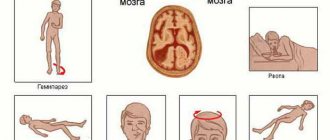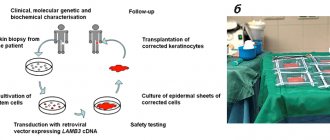There are many types eye injuries. They can be household, industrial, criminal, agricultural, children's, military. They can also be due to chemical or thermal burns. Injuries can vary in severity, external and penetrating. But in fact, with any eye injury, there is a deterioration in visual function.
The most common are work-related eye injuries. They account for more than 70% of all traumatic injuries to the eyeball. Most often they are received by workers involved in metal processing.
Statistics show that men (90%) are more susceptible to eye injuries than women (10%). In 22% of all cases, eye damage occurs in children and adolescents under the age of sixteen. Typically, childhood injuries occur as a result of careless handling of sharp and piercing objects.
Any damage to the organ of vision, even those that at first glance seem completely harmless and do not require medical attention, can lead to serious consequences, including complete loss of visual function and disability.
In case of eye injuries, until they are completely healed, ophthalmologists recommend using glasses to correct vision, since contact lenses themselves are a foreign body and can cause additional trauma to the eye tissue.
Depending on the degree of loss of visual function, three degrees of severity of eye injuries are distinguished:
- In mild cases, visual acuity usually does not suffer;
- With moderate injuries, temporary visual impairment is observed;
- Severe injuries are usually accompanied by a significant and persistent decrease in visual acuity.
In especially severe cases, the development of complete blindness is possible.
Penetrating eye injuries
Penetrating wounds of the eye, there is a violation of the integrity of its membranes. They can be torn, cut or chipped. In this case, ptosis, exophthalmos, and ophthalmoplegia develop. Such complications indicate deep wounds with damage to the deep structures of the eye and blood vessels, and damage to the optic nerve is possible.
Due to foreign bodies entering the eye, purulent complications may develop. The greatest danger in this regard is posed by organic substances or those containing any toxic components.
If a penetrating wound occurs in the limbal region, then, depending on the depth and size of the wound, a serious complication such as vitreous prolapse may develop.
When the lens or iris of the eye is injured, as well as when the lens bag ruptures, rapid clouding of the lens occurs and all its fibers swell. In such cases, post-traumatic cataracts form within a week. Metal fragments that get into the eye stain its tissues in unique colors. Around the foreign body (if it consists of iron), the rim of the sclera around the cornea turns rusty-brown; in the presence of copper, yellow or green.
Basic rules of treatment and preventive measures
Regardless of the nature of the damage, there is a list of actions that can only harm the victim. Among them is the desire to wipe the eyelid, make sure it is intact, and get rid of a fuzzy picture. Touching, rubbing, or pressing on the injured eye is prohibited. Firstly, you will increase the impact on the organ, and secondly, you can cause an infection and worsen the condition.
The second prohibition concerns the use of cotton wool. Do not attempt to rinse the eye with cotton pads or push out foreign bodies with cotton swabs. The villi will penetrate inside and only increase the discomfort. Cotton wool is used only when there is heavy bleeding, but such wounds can only be treated by a doctor under appropriate conditions. Another prohibition applies in the case of chemical burns to the organs of vision. Do not try to neutralize one chemical solution with another, this will increase the destructive effects of the liquids. You can only wash the wound with boiled water or antiseptic liquids that are intended for this purpose.
If a penetrating injury is suspected, rinsing the eye is prohibited. Wait for medical personnel to arrive and follow their instructions.
Mechanical injuries
Mechanical injuries - damage to tissues, bone structures, individual organs due to impact, bruise, fracture, etc. The intensity of pain and consequences vary depending on the force of the blow and its location. If the patient is conscious, but the integrity of the eye or its functionality is impaired, call an ambulance and provide first aid. Gently clean the damaged area of dirt with filtered water or an antiseptic solution. If possible, apply a cold object to the eye and apply a bandage. The main thing is to perform actions as carefully and gently as possible, without creating additional pressure.
With intense mechanical impact, damage and separation of the optic nerve occurs, which can lead to partial blindness. In this case, first aid should be provided by a doctor. The victim is injected with anti-tetanus serum, a broad-spectrum antibiotic, applied an aseptic bandage and taken to the hospital for further therapy. In case of heavy bleeding, loss of an eye, or serious injuries, it is better to wait for a doctor. Unqualified actions will only aggravate the victim’s condition. Contact an ambulance, explain the situation, listen to the doctor’s recommendations and follow them.
Chemical damage
In case of chemical damage, rinse the eyes and eyelids thoroughly with plenty of running water. Ideally, you should sit the victim at the sink, throw his head back, ask him to open his eyelids and rinse them until the ambulance arrives (but no more than 20-30 minutes). Only the damaged area needs to be washed.
If lime powder gets in, washing is strictly prohibited. Interacting with water will only intensify the burn and pain. Try to remove the crystals with a dry cloth and only then proceed with rinsing.
Upon arrival at the medical facility, the patient will be given anesthesia and will begin to remove particles that have entered the conjunctival sac. After this, the area is washed under running water for 5 to 30 minutes. Next, disinfectant ointment is placed behind the eyelids, a bandage is applied to the eye and, based on the patient’s condition, therapy begins.
Thermal damage
Thermal burns do not require washing the wound. It is enough to remove dirt from the eyelids, wipe with an antibacterial agent and place a cold object on the eye. The main thing is that no liquid gets into the damaged area. If you are using ice, wrap it in several layers of cloth/paper or place it in a plastic bag before placing it on your skin. The victim immediately develops increased photophobia. Darken the room you are in to eliminate additional irritation. If possible, apply antibacterial ointment to and behind the eyelid (be sure to wash and dry your hands first). After the ambulance arrives, the victim is given anti-tetanus serum, analgesics, and special solutions are instilled into the eyes. Severe burns will require surgery with excision and subsequent replacement of the cornea.
Presence of a foreign body
If the foreign body is too large, but it is impossible to remove it yourself, a frame should be created that minimizes the risk of displacement. Displacement will lead to greater trauma and will only worsen the victim’s condition. How and from what to make a frame? Use any available items that you can find. Ask the victim to take a comfortable, stable position and cover both eyes with a tissue. This will help to avoid paired simultaneous movements of the eyeballs, which will also affect the displacement of the foreign body. Place antibacterial drops in your eyes, wait for the ambulance to arrive, or take the victim to the emergency room yourself.
Eye bleeding
Develops after serious mechanical damage or deep penetrating trauma. Before the ambulance arrives, it is necessary to stop the blood loss as soon as possible. To do this, the victim is instilled with antibacterial drops and a sterile bandage is applied. You can use a sterile bandage or gauze as a bandage. If they are not there at the right time, use a clean napkin that has been previously ironed. Apply a blindfold to both eyes, as moving the eyeball at the same time can aggravate the situation and increase pain.
First aid for penetrating eye injuries
Treatment should be carried out by an ophthalmologist. First aid includes the removal of superficial foreign bodies. To do this, the victim should rinse his eyes with clean boiled water. After this, the eye is covered with a bandage and the patient is taken to the hospital. Upon admission to the hospital, the patient is examined, aimed at identifying foreign bodies and determining their exact location. After surgical treatment and removal of the foreign body, anti-inflammatory and antibacterial therapy is necessary. The administration of antitetanus serum is mandatory.
Complications of penetrating eye injuries
When injured in the limbus, purulent or serous iridocyclitis usually occurs, with the formation of pus in the inner membranes of the eye and the vitreous body. Painful sensations occur, vision decreases, the pupil becomes narrow and the accumulation of purulent contents in the anterior chamber is clearly visible. One of the complications of eye injuries is traumatic cataract. It is formed when the limbus or area of the cornea is injured; the lens may not become cloudy immediately, but some time after the injury.
The most severe complication is sympathetic inflammation, which threatens the loss of a healthy eye. Sympathetic inflammation is manifested by photophobia. Then, due to fibrin effusion, the iris adheres to the lens, which leads to complete occlusion of the pupil. Against this background, secondary glaucoma develops, from which the eye completely dies. To prevent the development of glaucoma in a healthy eye, doctors are forced to resort to removing the injured one.
From the long-term presence of metal foreign bodies in the tissues of the eye, diseases such as siderosis and chalcosis can develop, from which the boundaries of the visual field narrow, pigments form on the retina, secondary glaucoma, retinal detachment and complete atrophy of the eye can develop.
For any type of penetrating injury, the patient must seek help and treatment in a hospital.
Prevention of eye injuries
To protect your eyes from possible damage, you should adhere to the following rules:
- When doing construction and welding work, be sure to wear safety glasses;
- do not be in the sun without sunglasses;
- Follow labor safety rules when working in manufacturing plants.
In fact, labor protection is the most important system for preserving the life and health of workers in the process of work.
Managers of any enterprises must provide employees with training on industrial safety and labor protection in order to minimize the occurrence of emergency situations. Clean View Eye Clinic diagnoses and successfully treats any eye and eyelid injuries. You can find out more details and make an appointment by phone.
Non-penetrating eye injuries
These injuries are not associated with a violation of the integrity of the cornea or sclera. They usually occur as a result of large particles of sand, small insects, etc. getting into the eyes. In this case, the doctor can easily remove the foreign body under anesthesia. After which, the eye is washed with antiseptic solutions. For several days, the victim should instill antibiotic eye drops into the damaged eye several times a day, and at night put antibacterial ointments, such as tetracycline, behind the eyelid.
How is eye injury treated?
Treatment is selected based on the type and extent of eye damage. In mild cases, we manage with drug therapy, which includes antibacterial drugs, non-steroidal anti-inflammatory drugs, painkillers and hormonal eye drops. For moderate and severe burns, the patient is hospitalized; for serious wounds, surgery is performed. Treatment after an eye injury involves using drops recommended by your doctor.
Consequences of eye injury
The consequences of damage depend on its extent and the quality of assistance provided. Doctors treat wounds and carry out all necessary manipulations, so if you quickly go to the emergency room, there will be fewer complications. Undesirable consequences are associated with infection entering the blood or even greater injury as a result of rash actions.
If a person does not receive timely medical care, scars remain, the soft tissues around the eye are deformed, and visual acuity decreases until it is completely lost.
If the infection enters the blood, sepsis develops - inflammation that is dangerous to the entire body. Accumulating pus affects the internal structures of the eye, sometimes reaching the brain, causing inflammatory processes in the body.
Eye burns
The greatest danger to the eyes is burns. As a rule, they lead to significant damage to eye tissue. Their treatment is quite difficult and does not always lead to complete restoration of visual function. About 40% of victims eventually become disabled.
Of all burns, 75% are acid burns. They cause coagulative necrosis. The severity and consequences of such a burn are determined after a couple of days, since the acid does not immediately penetrate into the thickness of the eye tissue.
25% of burns are caused by exposure to alkalis. In this case, tissue protein dissolves. With such injuries, damage to the eye can occur from 5 minutes to several days. The exact severity of the burn can be determined only after 3 days. The greatest danger is a combination of acid, alkaline and thermal burns.










